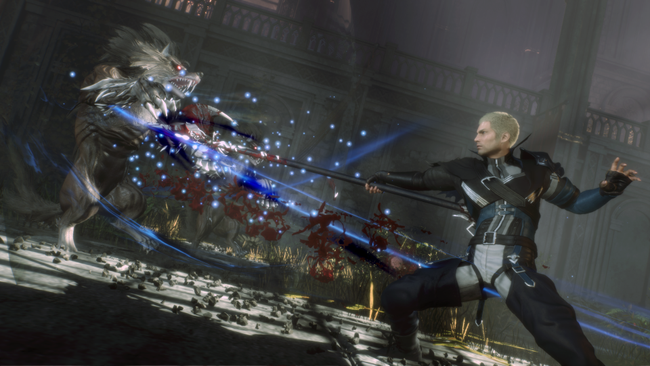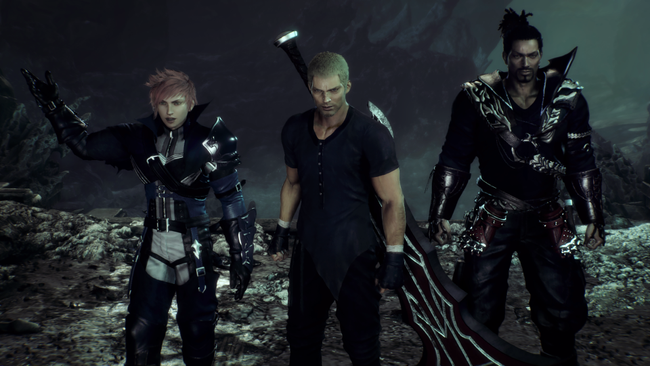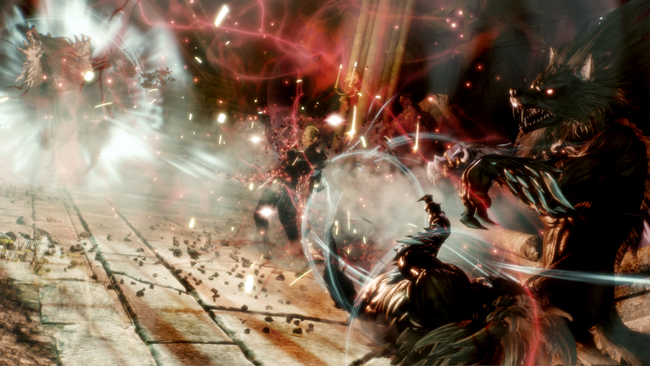
Stranger of Paradise Final Fantasy Origin's staff explain the game, its name, and even those character designs
Regardless of how you felt about its rather unique introduction, it’s safe to say that one of the biggest and most significant announcements of E3 was that of Stranger of Paradise Final Fantasy Origin, a unique new Final Fantasy title that’s been touted as a “bold new vision” for the series.
Famitsu’s latest interview features quotes from the game’s creative producer Tetsuya Nomura, the producer Jin Hujiwara, and director Daisuke Inoue. Much about the game remains unknown - but some of the comments from the development team do give us some insight into exactly what Stranger of Paradise Final Fantasy Origin is.
With credit to Weekly Famitsu for the original text, here’s some of the highlights from the interview - divided up into sections based on what we learn in each instance.
The story uses the first Final Fantasy as a ‘motif’, but isn’t necessarily a prequel, sequel, or otherwise directly connected to it
There’s a whole lot of the first Final Fantasy in the released demo of Stranger of Paradise. The entire demo is set in the Chaos Shrine, that game’s first major dungeon, and the final boss fight is against Garland, or Chaos - depending on how you look at it. We also briefly hear the words of Princess Sarah, who is also a key character in FF1.
Despite that, Stranger of Paradise isn’t necessarily directly connected to that groundbreaking game. That means that despite the ‘Final Fantasy Origin’ bit of the title, it also might not necessarily be a prequel, as Tetsuya Nomura explains.
“It’s a new story that uses Final Fantasy I as a motif, rather than being directly connected or an equivalent,” Nomura says. “The trial version covers the Chaos Shrine, which you’ll visit towards the beginning of the game – which is similar to the progression in Final Fantasy I as well.”
Those more modern, realistic character designs are deliberate - and they have a story meaning
As soon as the game was revealed, a lot was made of the designs of the characters - who look a lot more like your average dudes than your typical Final Fantasy characters. Putting aside the comparisons to Eminem or whatever, Nomura hints that the way these characters dress - and their more traditional names - all have meaning in Stranger of Paradise’s story.
“Yes, people probably imagine characters that look like the emblematic Warrior of Light when they think of Final Fantasy I, but as you say, if you’re familiar with the premise of FF1, you might be able to pick up some clues from the designs of Jack and the others,” Nomura says - responding to the observation of Famitsu’s interviewer that the lot of the first Final Fantasy revolved around time travel, with the Chaos Shrine a key part of that scheme.
“The initial outfits for Jack and his allies are nothing more than a hint to show that they’re not of that world. They don’t represent anything about their character. Like other games where you can change your equipment, this is simply their plain state.”
Nomura says that one of the core concepts of the game was to “create something that looked completely different to what people might picture when they think of the Warriors of Light fighting Garland.” There’s a deliberate attempt to separate these characters visually from the traditional FF pantheon, though they’ll begin to look more like traditional FF characters as they wear new equipment found in the game world.
“The reasoning behind Jack’s appearance is purely related to the story,” Nomura reveals. “Likewise, there’s meaning behind all of their names. But that would be a spoiler, so I’ll save that for another time.”

The game came from two different ideas: a desire to work with Team Ninja in its area of expertise, and Nomura’s vision for a different sort of FF
The interview tackles the detailed story of how Stranger of Paradise came to exist in the first place - and perhaps unsurprisingly, it’s not as clear-cut as one person having an idea. In fact, it was born out of two desires: one around the developer, Team Ninja, and the other an idea that Tetsuya Nomura had been considering for a while.
“We wanted to undertake a new challenge together with Team Ninja from Koei Tecmo Games,” Inoue says. Square Enix and Team Ninja had previously worked together on the most recent Dissidia Final Fantasy title.
“Team Ninja specializes in action games, so we decided to make use of their expertise, which led to us settling on the genre of action RPG.”
“Personally, what I was envisioning was a Final Fantasy game that wouldn’t specifically use the FF name, under a completely new title, “Stranger of Paradise”, that would feature action gameplay focused on fighting your way through dungeons,” Nomura adds. “The current game is a result of Mr. [Jin] Fujiwara and Mr. Inoue refining it further, but I’m glad that traces of that original concept still remain.”
The title has a fairly straightforward meaning
Stranger of Paradise Final Fantasy Origin is a bit of a mouthful even by Square Enix game name standards, but in the interview Nomura and Inoue are both keen to point out that the title has some clear meanings.
“In FF1, at the end of the game you find out who the Warriors of Light, the protagonists, really are and where they came from,” Nomura notes.
“Jack and his allies are also “strangers”. Who are Jack and his allies? Are they the Warriors of Light? These questions lie at the heart of the story, and this idea of “strangers” is central to the plot. One meaning of Paradise is “the land of the saved”. The title represents the strangers – Jack and his allies – gathering in this land of Paradise.”
“Strangers of Paradise means exactly what it says that these strangers are in the land of Paradise. At the same time, it could mean “people who shouldn’t be in Paradise” – I think it is a title that represents the story of the game perfectly,” adds Inoue.

There will be more party members beyond those we’ve seen - but unlike FF1, the party size caps out at three, and party progression is still under consideration
In the trailer we get to see protagonist Jack alongside two friends, Jed and Ash. These pair aren’t the only party members you’ll have in the game, however, with Nomura confirming that there will be more party members in combat.
“However, during combat, you’ll fight with a party of three members,” game director Daisuke Inoue notes. “So you’ll be swapping people around for battle.”
Party members weren’t always guaranteed for the game, but it was a key part of the Final Fantasy formula the developers wanted to keep intact. With that said, the development team is currently undecided on how exactly allies might grow and progress.
“That’s something we’ll investigate on the basis of the feedback we get from the trial version. At the very least, the plan is to be able to customize their growth and equipment,” Inoue reveals.
“Each of your allies will have certain jobs that they excel at – if you imagine that Jed might be suited to being a thief, while Ash might be suited to being a monk. We’re envisaging different kinds of playstyle, for example, where you could get your teammates to act as a target while you attack with magic.”
Jack can equip eight different types of weapon, including five not in the trial version
Protagonist Jack has a job system in the truest Final Fantasy tradition, and he can equip a great sword, mace, and spear. As we see in the demo, each base job can be advanced to a more powerful one, too.
“There will be eight weapon types in total,” Inoue confirms. “The weapon types that don’t appear in the trial version are the one-handed sword, axe, knuckles, daggers, and katana.”
Eagle-eyed readers might notice that most of these weapon types - all save daggers - appear in Nioh, which appears to share a fair amount with Stranger of Paradise.
Inoue confirms that weapons other than the mace can use magic; one-handed sword users can wield it in the style of a Knight or Red Mage job in traditional FF.
There’s a lot of gear & equipment - and all outfit designs were checked by Nomura
In the interview, Inoue teases that he’s counted all of the equipment items currently in the game, and while he doesn’t reveal exactly how many that is, he says it’s “a lot”, something which amuses Nomura.
Nomura also says that he has personally checked the outfit designs for the various equipment items in the game.
As well as equipping Jack, players will also be changing the gear of their party members - and this is something that’s important, despite not being a feature in the trial version.
“There’s some strong equipment that Jack can’t use, which I think you’ll want to
give to your allies,” Inoue says. “Each character has certain restrictions on what they can equip.”

While it has similarities to Souls, it’s designed to be true to Final Fantasy - which means accessible and not too punishing
A lot of people immediately compared Stranger of Paradise to Tecmo Koei’s work on Nioh, something which actually seems pretty savvy given the obvious similarities between the two games. However, the team are working hard to ensure that it’s a Final Fantasy game first and foremost - and the team knows that not all FF fans, who are used to traditional RPGs, are comfortable with action games.
“If we made it an especially punishing game, then only the players who actively seek out that
kind of game would play it,” admits Inoue. “One of our aims in combining FF with this kind of challenging action genre was to make these kinds of games more accessible. We want to make it a game where players can get a taste of how rewarding challenging action games can be, so our ultimate aim is to develop it as “challenging” rather than “punishing”.
A number of systems are deployed to make the game more manageable, including difficulty modes. Inoue gave Famitsu a brief run-down of some of the ways Stranger of Paradise works to make FF fans feel welcome.
“The penalty for dying is quite lenient, and with a lot of experimentation from the development team at Team Ninja, we’ve balanced the actions like evasion, guarding and the soul shield to be relatively easy to perform successfully, Inoue says.
“In terms of difficulty settings, we’ve implemented a Casual mode as part of Easy mode. For people who aren’t familiar with action games, I would recommend playing with these settings initially, and trying to increase the difficulty as you become more familiar with the game. We’ll continue to adjust the difficulty settings using the feedback from the trial version, so I’d really love to hear everyone’s opinions.”
“Of course, we’re also hoping it will be a good opportunity for fans of action games to experience FF as well.”
The composer team includes veterans of FF11, FF13-2, Crystal Chronicles, and World of Final Fantasy
The main composer of the game is Naoshi Mizuta - famed as one of the main composers on Final Fantasy XI and also a key contributor to FF13-2. They’re joined by Hidenori Iwasaki of Crystal Chronicles: The Crystal Bearers and Front Mission fame, and Ryo Yamazakim a veteran who has contributed to Balan Wonderworld and World of Final Fantasy.